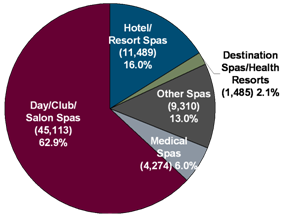‘Spas’ and ‘Medical Tourism’
- Published: Thursday, September 23rd 2010
- in Living Well
‘Spas’ and ‘Medical Tourism’
Two Booming Industries With Strikingly Parallel Paths and Issues
By Susie Ellis, President of SpaFinder Inc. – the world’s largest spa media, marketing and gifting company
Am currently attending the 3rd annual Medical Tourism Conference in LA. While I will summarize the very latest information in an upcoming blog, I thought it would be valuable to post 2 articles that I have written on the topic of comparing the spa industry and the medical tourism industry because they will serve as foundational information.
I know this post is lengthy, I apologize for that however it is the entire article I wrote for Medical Tourism magazine last year. Most in the spa industry have never read it…so here it is for those interested in a conversation that is of increasing interest to more in the wellness arena. (This year their conference includes a track on wellness and spas.)
The global spa industry, with $60 billion-plus in core revenues and another $194 billion in spa-related hospitality, tourism, etc. is a vibrant and fast-growing global industry, clocking an average yearly growth rate of 20% for the past two decades. The same vitality is, of course, seen in the booming global medical tourism industry, also currently estimated as a $60 billion market – and expected to grow to $100 billion by 2010.
 While each category is unique, these vast, growing global markets are increasingly intersecting and interweaving in creative and potentially synergistic ways. And while both the modern spa and medical tourism industries are in early phases of development, each sector’s growth is being galvanized not only by the rapid globalization of all economies, but also consumers’ quickening desire for diverse, meaningful health and wellness alternatives.
While each category is unique, these vast, growing global markets are increasingly intersecting and interweaving in creative and potentially synergistic ways. And while both the modern spa and medical tourism industries are in early phases of development, each sector’s growth is being galvanized not only by the rapid globalization of all economies, but also consumers’ quickening desire for diverse, meaningful health and wellness alternatives.
Because these industries have much to learn from each other, and because it’s a critical time to jumpstart a dialogue between stakeholders to help shape a mutually beneficial future, in the first installment of my two-part discussion I will present some background on each sector and in the second part suggest ways the industries could work together. What quickly becomes clear is that not only are both industries of strikingly similar size and scope, they share unusually parallel paths, and confront analogous key issues.
Both…
…Are ancient, and yet, distinctly young industries
…Share terminology and conceptual challenges
…Have a critical need for supporting, credible research
…Share a need for expert facilitators and agents to guide consumers and grow industry
Ancient, and Yet So Young
Both the spa and medical tourism industries can trace their roots back to the earliest historical epochs; people have always sought places for the renewal of body, mind and spirit (spas) just as they have, for centuries, been traveling across borders for medical reasons (medical tourism).
Greek writers spoke of a variety of baths as early as 500 BC. Later the Roman emperor Agrippa was credited with developing the first ‘thermae,’ a large-scale spa with numerous bathing stages including hot and cold baths and massage. From taking the waters in Europe, to onsen bathing in Japan, to temescal sweat lodges enjoyed by Native Americans, to the hammams of the Arab world, the idea of visiting a place designed for relaxation and rejuvenation is nearly as old as human civilization.
The concept of medical tourism is equally ancient, dating back thousands of years. Some commentators peg the Greek pilgrims traveling to the Saronic Gulf (called Epidauria, the territory of the healing god Asklepios), as the official birthplace of medical tourism. Others would argue that people journeying to India for yoga and Ayurveda were among the first medical spa travelers. Cairo’s Mansuri Hospital, constructed in the 13th century AD, represents an early example of an advanced hospital that attracted health travelers from distant lands.
Also of interest, both spa and medical tourism’s histories directly intersect in towns such as St. Moritz, Baden Baden, and Bath, which attracted royals from across borders to their healing baths.
But while each concept boasts an ancient history, both spa and medical tourism have witnessed a distinct, more recent development timeline that could properly be called the ‘modern spa industry’ or the ‘modern medical tourism industry’ –more properly measured in decades rather than centuries.
The modern global spa industry is often pegged to 1986 when the first company to aggregate spa going opened its doors. Called SpaFinder, it was designed as a new kind of travel agency specializing in spas; it published its first worldwide spa catalog that same year. Following this conceptual breakthrough, the term ‘spa’ was adopted by an exponentially greater number of establishments, and the term and concept caught on with both consumers and the media, first in the U.S., and then around the world. Less than 25 years later, there were are now approximately 72,000 spas around the world in 2007 and that figure is estimated to have increased to approximately 80,000 at minimum today..

In a similar vein, the modern concept of medical tourism emerged only recently, perhaps even more recently than the spa sector. Fueled by a variety of factors such as the high cost of health care, long wait times for certain procedures, the ease and affordability of international travel, and improvements in both technology and the standards of care in many countries, medical tourism has become a term talked about around the world in the last decade. Key developments which supported the emergence of medical tourism as a defined industry include the Joint Commission International (JCI) inspecting and accrediting health care facilities outside of the U.S. in 1999 and the launch of the Medical Tourism Association in 2007. Several key studies from 2008, including McKinsey’s ‘Mapping the Market for Medical Travel’ and Deloitte’s ‘Medical Tourism, Consumers in Search of Value’ gave further exposure and shape to the young sector.
Terminology and Definition Challenges
Perhaps it isn’t surprising that when a modern new industry emerges, and expands its offerings and focus at breakneck speed, that there would be debates over terminology and definitions. This has certainly been the case in the spa arena, and it is becoming evident in the evolving world of medical tourism. Both industries are marked by disagreements about what, in fact, to call themselves, as well as what the concept actually encompasses.
There is general consensus that the origin of the term ‘spa’ hails from Europe as an acronym for the Latin sanitas per aquam, which literally means health through water. The term is also linked with a mineral-springs-rich town in Belgium, which christened itself Spa in the 16th century.
The United States adapted the term ‘spa’ when Saratoga (in upstate New York) opened, fashioning itself after European towns where people went to ‘take the waters.’ Others, however, later used the term more broadly to describe destinations with a focus on exercise, weight loss, or beauty. And when the Jacuzzi brothers developed their hydrotherapy machine in the 1950s, dubbing their home whirlpool contraption a ‘spa,’ the line was blurred even further.
Given the etymological history of the term, it’s not surprising that one of the key debates has been whether an establishment that did not incorporate natural mineral waters could legitimately dub itself a ‘spa.’ Additional terminological nitpicking arose when spa associations began springing up around the world, and, having to decide who could gain admission to their organizations, began crafting their own definitions. Some insisted that a proper spa must offer water treatments; others believed that an establishment must offer two out of three of these services: massage, facials and body scrubs while others argued a true spa most offer at least 5 treatment rooms, etc.
As the industry exploded, and new concepts like destination spa, hotel spa, resort spa, day spa, club spa, cruise ship spa, and spa living real estate hit the scene, there was a need for more precise categorization to help consumers distinguish between the ever-multiplying menu of offerings. And, specially germane to the topic of this article, in the 90s the concept of the ‘medical spa’ and medi-spa’ were introduced.
So, while one can still hear murmuring about the water/ no water debate today, the general consensus seems to be that using the broadest definition of the term ‘spa’ is the smartest solution, with narrower subsets then carved from that umbrella. Industry experts finally realized that consumer perceptions and preferences were worth taking into consideration. Real-world spa-goers did not demand strict definitions; they knew a spa when they saw one.
The issue was ultimately put to rest when the respected research firm SRI International (formerly the Stanford Research Institute) issued the first Global Spa Economy Report in 2007. Having studied this global debate, SRI analysts concluded that the following broad definition would satisfy consumers, while still allowing industry professionals to carve out meaningful niches:
“Spas are establishments that promote wellness through the provision of therapeutic and other professional services aimed at renewing the body, mind and spirit.”
The medical tourism industry also finds itself embroiled in debates about core definitions, as well as whether other, more appropriate terms should prevail. Here are just a few examples of terms vying for supremacy: ‘Medical Travel,’ ‘Health Travel,’ ‘Health Tourism,’ ‘Global Healthcare,’ and ‘Medical Treatment Abroad’ – not to mention upstarts like ‘Wellness Tourism/Travel,’ ‘Medtrotting,’ or ‘Cross-Border Health Tourism.’ Some argue the term ‘tourism’ should not be used at all.
Some leading definitions:
“Traveling internationally for medical care” (Medical Tourism Association)
“The idea of traveling around the world for medical treatment” with ‘medical travelers’ defined as “people whose primary and explicit purpose in traveling is medical treatment in a foreign country.” (McKinsey)
“Healthcare consumers leaving home for treatments and care abroad or elsewhere.” (Deloitte)
Travel agencies and the mass media seem to be settling on the term ‘medical tourism’ – and 50 countries have identified ‘medical tourism’ as a national industry – and South Korea has even established a ’medical tourist visa.’ With the World Health Organization having a stake in keeping the term ‘tourism’ in the mix and the Medical Tourism Association holding its third second global conference using that name, the ‘medical tourism’ designation should be further solidified.
While it will be interesting to watch the terminology debates unfold, personally I think it’s difficult to put the genie back in the bottle. The momentum among consumers and the media is unmistakable, and my prediction is that the terms ‘spa’ and ‘medical tourism’ will prevail. Establishing industry consensus on definitions and language (which consumers and the media have already accepted) represents a positive step, and is likely to move the industry’s growth along more quickly than the costly branding of new terms that can cause confusion.
The Need for Credible, Supporting Research
In a young industry’s early stages, information and data tends to be fragmented and scattered, if it’s even available. An entrepreneurial spirit prevails and decisions are made from the ‘gut.’ It takes time for all the diverse industry participants to understand the value of supportive, authoritative research, but data and expert industry analyses uniquely benefit a growing industry, helping all players make better decisions by establishing benchmarks.
The spa industry identified this need early on, and much credit needs to be given to the International Spa Association (formed in 1991), which was responsible for the first U.S. spa industry research. ISPA continues to invest in various research projects, building a credible information database that’s widely available to its members today. In time, other organizations and countries around the world began following suit. And by 2007, the first truly global industry data was aggregated and presented at the second annual Global Spa Summit, held in New York. (For a complete list of spa research go to the resource section of www.globalspasummit.org.)
While the even younger medical tourism arena is in an earlier phase of data gathering, things are changing. For instance, both Deloitte and McKinsey contributed valuable reports to the conversation this past year. And while their vastly different numbers underscored that agreements on industry definitions and measurement remain unsettled, progress is being made. The Medical Tourism Association recently reported the results of their first survey, which should help galvanize ongoing research. Also of note, Dr. David Vequist is squarely addressing the need for data through the foundation of the Center for Medical Tourism Research, the first such research center in the world.
Going forward both spas and medical tourism need to pursue, underwrite, and promote as much consumer-facing data and information as possible as well as continue to encourage industry studies.
Travel Agents and Medical Tourism Facilitators
In the spa world, consumers often make their own travel arrangements, especially with the advent of the Internet and, additionally, the recent rise of spa reviews online. But with thousands of spas worldwide, travel agents (in particular spa travel specialists such as those trained by SpaFinder) are often vital in facilitating a great match between travelers and their ideal spa experience, especially if it includes traveling overseas.
While there’s no mandated license for travel agents, there are various best practices (such as being bonded), which have made agents a trusted, reliable way to book travel and accommodations. Despite recent changes in the way some agents exact their commission, the fact that they have been around for almost a century has ensured a great deal of transparency in the system.
With medical travelers facing an even more complex process (foreign countries, languages and currencies, and serious procedures), many people choose to rely on help – and that has come in the form of the ‘medical tourism facilitator.’ As with travel agents there is no required licensing, and because the industry is so young, the ‘facilitator’ can range from a Mom-and-Pop operation that threw up a website, to a seasoned professional that has assisted with hundreds of successful experiences. With the ‘facilitator’ industry less than a decade old, there are potential quality problems, and the revenue and commissions often remain less-than-transparent. Nonetheless, industry progress is being made, and initiatives such as the Medical Tourism Association’s efforts to establish accreditation programs will no doubt be helpful.
The spa and medical tourism industries – unique, distinct market concepts – are increasingly intersecting and dovetailing as the march to find powerful health and wellness options continues. In Part II of my discussion I will discuss what’s percolating on the spa-medical tourism world stage today, propose some partnership models which are likely to work best, and point out a potential pit-fall to avoid. Discussions now can ensure a very bright future for both industries.
My twitter address: @susieellis


